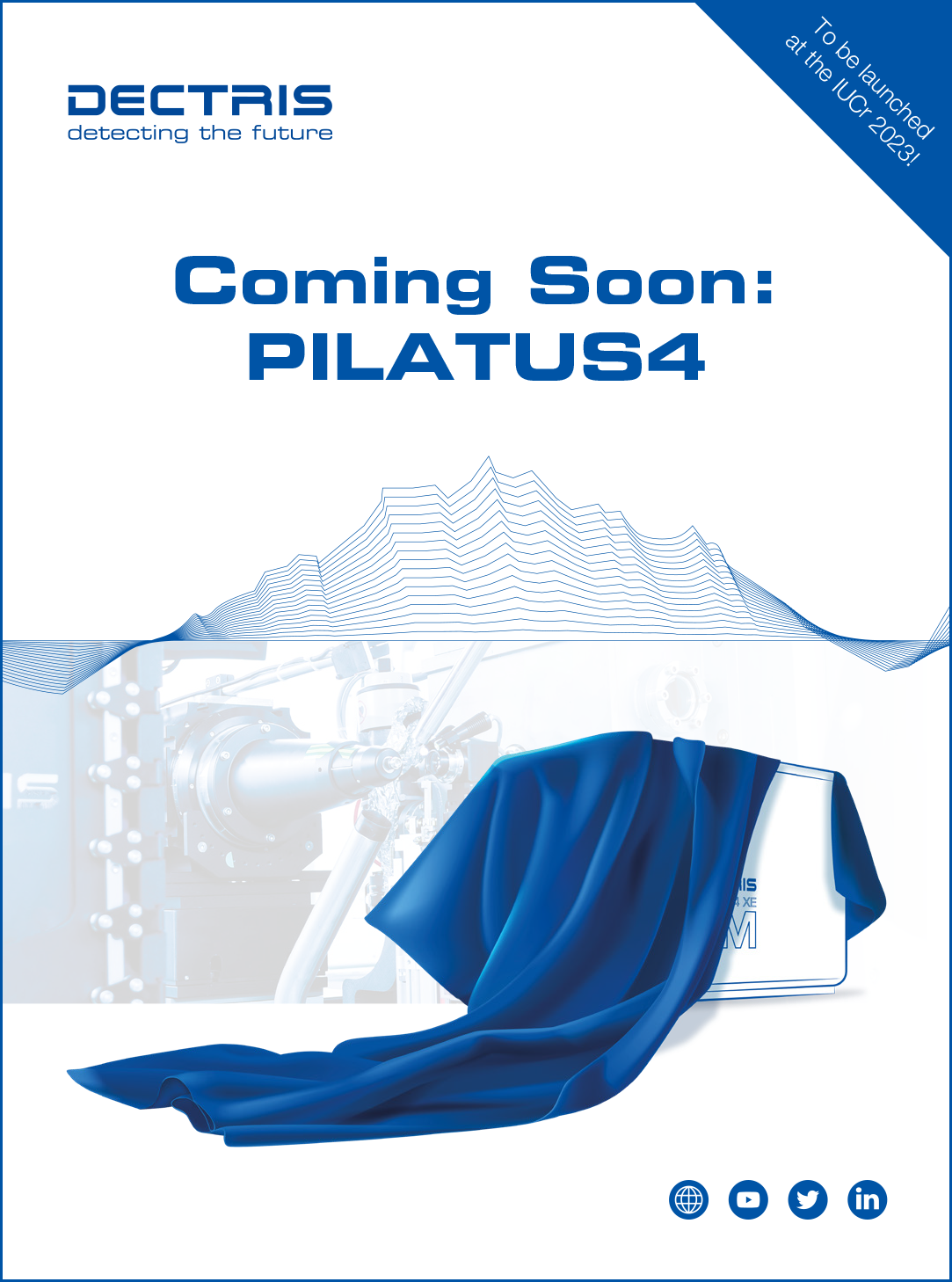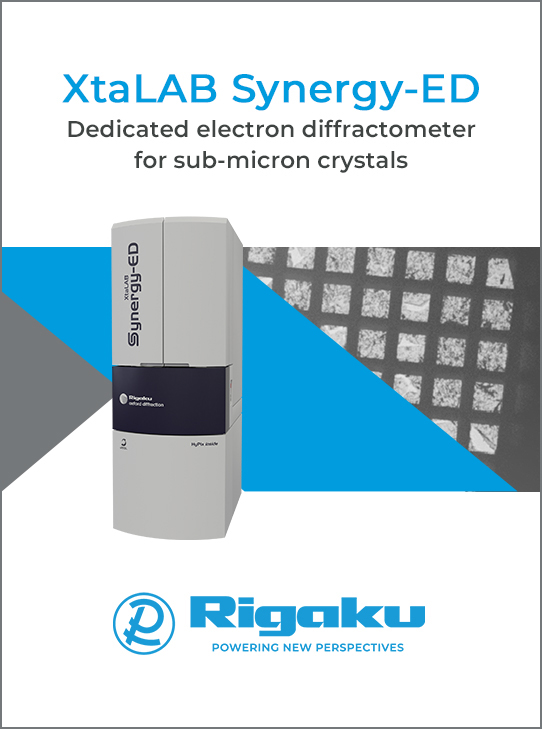


Commentary
Mapping structural correlations in real space
![thumbnail [thumbnail]](https://www.iucr.org/__data/assets/image/0009/156825/me6221fig1.jpg)
Figure 1. (Left) Diffuse scattering in Q-space from equal concentrations of two different atomic species with differing ionic radii occupying random sites on a square lattice. (Right) Three-dimensional difference pair distribution function (3D-ΔPDF) map in real space showing peaks with both positive (red) and negative (blue) intensities representing the change in the probabilities of their respective interatomic vectors compared with the average structure. The 3D-ΔPDF transforms reveal both the size of the local relaxations and the length scale over which those relaxations are correlated (P. Upreti, private communication).
The very first issue of Acta Crystallographica contained an article by Kathleen Lonsdale on single-crystal diffuse scattering (Lonsdale, 1948). Admittedly, her focus was on thermal diffuse scattering, but it illustrates the fact that the value of understanding the scattering between the Bragg peaks was recognized from the earliest days of X-ray diffraction. Since then the power of diffuse scattering, whether of X-rays or neutrons, in probing disorder within crystalline materials has been demonstrated by measurements on a wide range of materials from metallic alloys to molecular solids. An excellent introduction to the subject is provided by one of Lonsdale's last students, Richard Welberry (Welberry, 2022). Nevertheless, in spite of this long history, I think it is fair to say that diffuse scattering is not as widely used as might be expected, given the importance of local structural correlations in the functionality of so many materials. In the past, this was due to two major challenges, the challenge of measuring scattering that was several orders-of-magnitude weaker than Bragg peaks over large three-dimensional volumes of reciprocal space and the challenge of modeling the results. With advances in the power of both X-ray and neutron sources as well as the more widespread availability of large area detectors, high-quality diffuse scattering data is now much easier to collect, but the second challenge is still a deterrent to non-specialists, in spite of the existence of a number of software tools for atomistic modeling (Proffen & Neder, 1997; Paddison, 2019).
The relatively recent development of three-dimensional difference pair distribution function (3D-ΔPDF) analysis may encourage some scientists to give diffuse scattering another look. Patterson maps, i.e. 3D maps of interatomic vector probabilities produced by the Fourier transformation of S(Q), have long been used by crystallographers as a tool in solving crystal structures. What Thomas Weber and colleagues at ETZ Zürich realized is that if it were possible to eliminate scattering from the long-range ordered structure before performing the transform, the resulting maps would only contain interatomic vectors whose probabilities differ from the average (Weber & Simonov, 2012). These are difference Patterson maps, hence the Δ in 3D-ΔPDF. This is accomplished by removing the Bragg peaks at integer (hkl) values and replacing them with interpolations of the surrounding diffuse scattering, a procedure known as 'punch-and-fill.' 3D-ΔPDF maps filter out the average structure entirely, allowing us to focus on the changes in site occupations and atomic relaxations caused by local disorder. This is not possible with polycrystalline PDF data, in which there is no way to separate Bragg and diffuse contributions without sophisticated modeling. In 3D-ΔPDF maps, the smoothly varying distributions of intensity in Q-space are transformed into discrete spots in real space, with both positive and negative intensities reflecting increases or decreases in their respective vector probabilities compared with the average crystal structure (see Fig. 1).
The beauty of this method is that 3D-ΔPDF maps are relatively easy to interpret even without any modeling. The article by Schmidt et al. (2023) in this issue demonstrates this with an analysis that combines new neutron and X-ray data from yttria-stabilized zirconia (YSZ). The diffuse scattering in YSZ is extremely strong because of a high concentration of oxygen vacancies. This, coupled with the commercial availability of large single crystals produced as artificial diamonds, has encouraged several diffuse scattering investigations using both neutrons and X-rays over the past forty years. These have used increasingly sophisticated instrumentation as it became available, from the initial raster scans of a single Q-plane using a neutron triple-axis spectrometer that I once participated in (Osborn et al., 1986) to more complete reciprocal space volumes collected with neutron and X-ray area detectors (Welberry et al., 1995; Goff et al., 1999). However, the results have been somewhat qualitative even after employing a variety of modeling methods. In the new study by Schmidt et al. (2023), shifts in interatomic vectors are determined directly from the 3D-ΔPDF maps, producing more definitive values of the relaxations of both anions and cations around vacancies. The authors also performed atomistic simulations to reproduce the PDF peak intensities but these only served to confirm their original interpretations. Intriguingly, the size of the relaxations they observe are significantly greater than those derived from Bragg peak analysis, but the consistency between the neutron and X-ray data suggests the numbers are reliable.
The observed relaxations of nearest neighbors around a vacancy do not yield many surprises. More controversial is whether the vacancies tend to form pairs along the unit-cell diagonals, with or without cation interstitials. By contrasting the neutron PDFs, which are sensitive to oxygen pairs, with X-ray PDFs, which are less so, Schmidt et al. (2023) concluded that there was an increased probability of ⟨½½½⟩ vacancy pairs, but not between cation interstitials. They also found no evidence of longer-range correlations, which would have provided evidence of extended vacancy complexes. This is somewhat surprising as, with 18 mol% Y2O3, there are quite sharp diffuse peaks in Q-space, indicating that correlations extend to 15 Å or more (Osborn et al., 1986; Goff et al., 1999). One of the strengths of 3D-ΔPDF maps is that they allow correlations to be determined over a much greater range of length scales than polycrystalline PDFs. In our own work on sodium-intercalated V2O5, we were able to measure the growth of structural correlations in the sodium substructure with decreasing temperature from 10 Å to 200 Å (Krogstad et al., 2020). The new X-ray measurements were performed with a laboratory source, so synchrotron studies to look for very weak PDF signals at longer distances might be worth considering.
In the latest edition of his book, Welberry points out that 3D-ΔPDF vector probabilities 'are simply related to the Warren–Cowley short-range order parameters that have frequently been used to parametrize diffuse scattering models' (Welberry, 2022). In other words, 3D-ΔPDF maps can, if properly interpreted, provide as much, if not more, information than can be derived by atomistic modeling in reciprocal space. Some modeling might still be necessary in multicomponent systems, in which there is ambiguity about the origin of each PDF peak, but the problem is considerably simplified by the dimensionality reduction produced by transforming S(Q) to a discrete set of vector probabilities. This presupposes that the original data is of high enough quality and completeness that the transforms are numerically robust and that care is taken not to introduce spurious Fourier artifacts in the 'punch-and-fill' process. Exploring methods of improving the reliability of 3D-ΔPDF maps could help to stimulate the surprisingly undeveloped field of three-dimensional spectral analysis. Nevertheless, there are an increasing number of 3D-ΔPDF results appearing in the literature each year, and this new work illustrates why it is becoming so popular and promises soon to become a commonly used tool in characterizing disordered materials.
Acknowledgements
I am grateful to Puspa Upreti for providing the calculations used in the figure. Work by RO is supported by the US Department of Energy, Office of Science, Office of Basic Energy Sciences, Division of Material Sciences and Engineering.
References
Lonsdale, K. (1948). Acta Cryst. 1, 12–20.
Paddison, J. A. M. (2019). Acta Cryst. A75, 14–24.
Proffen, Th. & Neder, R. B. (1997). J. Appl. Cryst. 30, 171–175.
Weber, T. & Simonov, A. (2012). Z. Kristallogr. 227, 238–247.
Welberry, T. R. (2022). Diffuse X-ray Scattering and Models of Disorder. Oxford University Press.
Welberry, T. R., Withers, R. L. & Mayo, S. C. (1995). J. Solid State Chem. 115, 43–54.
This article was originally published in Acta Cryst. (2023). B79, 99–100.
Copyright © - All Rights Reserved - International Union of Crystallography







